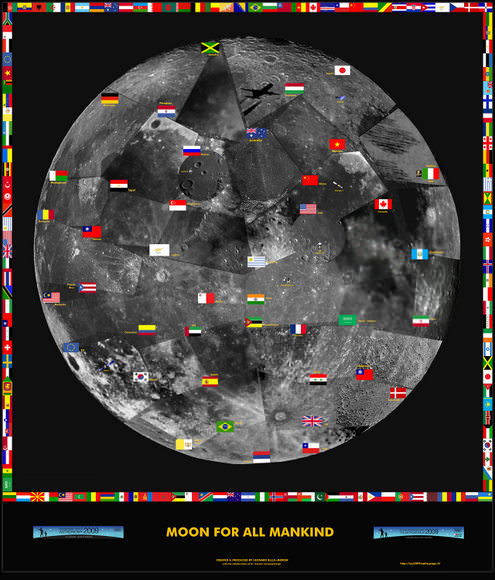[/caption]
The archipelago of Malta has coordinated a global campaign to take images of sections of the Moon’s surface as seen from 40 countries, and combine them in this commemorative, symbolic whole called the “Moon for All Mankind.”
The composite was released today, which marks the 40th anniversary of the Apollo 11 launch. Monday will be the anniversary of the landing.
Update: The Malta IYA Committee wrote to share this link with UT readers — a really fascinating animation they created. Check it out!

On the composite, the United States was assigned the region of the Sea of Tranquility, the location of the Apollo 11 landing on July 20, 1969. The U.S. image was provided by amateur astronomer Mark Sibole of Fife Lake, Michigan, the builder and operator of Mark’s Tin Shed Observatory (MTSO). The image was captured on June 12, 2009, using Meade LX200R 10-inch telescope and a DSI PRO III imager. The final composition is a stack of 100 images at 0.14 seconds autostacked in Envisage.
“I’ve done many lunar images, but this is the first time that I set out to zero in on one specific area,” Sibole said. “Everyone wants to ‘capture’ the Moon, and I’m pretty happy with the result.”
Besides Apollo 11, the image commemorates the International Year of Astronomy 2009 (IYA2009), as well as the 50th anniversary of the first robotic lunar landing by the Russian Luna 2 probe. Other countries to have launched spacecraft to the Moon include Japan, Europe, China and India; these probes are also featured in the image.
Most of the images were taken during the May or June full moons of 2009 but some were older, and Italy’s was a four hundred year-old sketch by Galileo Galilei.
Malta is an archipelago of small islands in the Mediterranean with a population of just over 400,000 people. It has a rich history and is home to the oldest free-standing stone structures in the world. It is claimed that these temples, which are thousands of years old, were aligned to the solstice and so there has been a strong astronomical tradition in Malta for many centuries.
Source: IYA2009, via the American Astronomical Society (AAS) press wire. To find out more about Mark Sibole and his observatory on the Web, visit astronomy.qteaser.com.


Thanks, Anne, for the story behind the final image. I found the video link provided greatly added to the overall image and was nicely done. Definitely check out the video!
Hmm… Its very bad concept.
Its not fair enough to let other countries who didn’t bother to do the work needed to get there and instead funded other things like war, terror etc get a share of the moon.
Simply put, finders keepers.